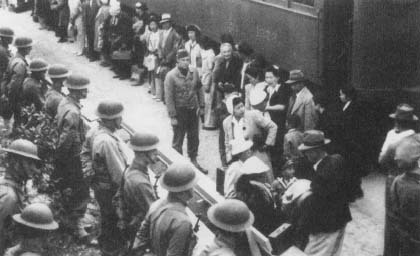Ex Parte Endo Trial: 1944
Petition And Appeal Stretch Over 21 Months, Confined Under Armed Guard, Suggestions For Further Reading
Appellant and Defendant: Mitsuye Endo
Appellant Claim: Entitlement to habeas corpus
Chief Lawyer for Plaintiff: Charles Fahey
Chief Lawyer for Appellant James C. Purcell
Justices: Chief Justice Harlan F. Stone; Justices Hugo L. Black, William 0. Douglas, Felix Frankfurter, Robert H. Jackson, Frank Murphy, Stanley F. Reed, Owen J. Roberts, and Wiley B. Rutledge
Place: Washington, D.C.
Date of Decision: December 18, 1944
Decision: Judgment reversed and the cause remanded to district court
SIGNIFICANCE: This Supreme Court decision ended what the American Civil Liberties Union later called "the worst single wholesale violation of civil rights of American citizens in our history."
In February 1942, soon after the Japanese bombed Pearl Harbor in the surprise attack that committed the United States to World War II, President Franklin D. Roosevelt authorized the War Relocation Authority to detain persons of Japanese ancestry living on the West Coast, many of whom were not only American citizens but native-born.
Military commanders were authorized to designate areas from which such persons could be excluded; if they lived within those areas, the military could move them. Lt. General J. L. De Witt, of the Western Defense Command, proclaimed that the entire Pacific Coast of the United States:
[B]y its geographical location is particularly subject to attack, to attempted invasion by the armed forces of nations with which the United States is now at war, and, in connection therewith, is subject to espionage and acts of sabotage, thereby requiring the adoption of military measures necessary to establish safeguards against such enemy operations.
On those orders, 110,000 Japanese-Americans, 75,000 of whom were U.S.citizens, were removed from their homes. Meantime, Congress enacted legislation that ratified and confirmed the president's order.
Mitsuye Endo, a native-born American whose ancestors were Japanese, was taken from her home in Sacramento, California, to the Tule Lake War Relocation Center at Newell, California. Endo was 22. A Methodist who had never visited Japan and neither spoke nor read Japanese, she worked in the California Department of Motor Vehicles. At Tule, she and the others found they could not leave the center without written permission issued by the War Relocation Authority.
 President Franklin Roosevelt authorized the relocation of people of Japanese ancestry after the attack on Pearl Harbor
President Franklin Roosevelt authorized the relocation of people of Japanese ancestry after the attack on Pearl Harbor
Additional topics
- Ex Parte Quirin - Significance, Supreme Court Holds Special Session As Saboteurs Face Death Penalty
- Ex Parte Endo - Significance, Petition And Appeal Stretch Over 21 Months, Confined Under Armed Guard, Further Readings
- Ex Parte Endo Trial: 1944 - Petition And Appeal Stretch Over 21 Months
- Ex Parte Endo Trial: 1944 - Confined Under Armed Guard
- Ex Parte Endo Trial: 1944 - Suggestions For Further Reading
- Other Free Encyclopedias
Law Library - American Law and Legal InformationNotable Trials and Court Cases - 1941 to 1953